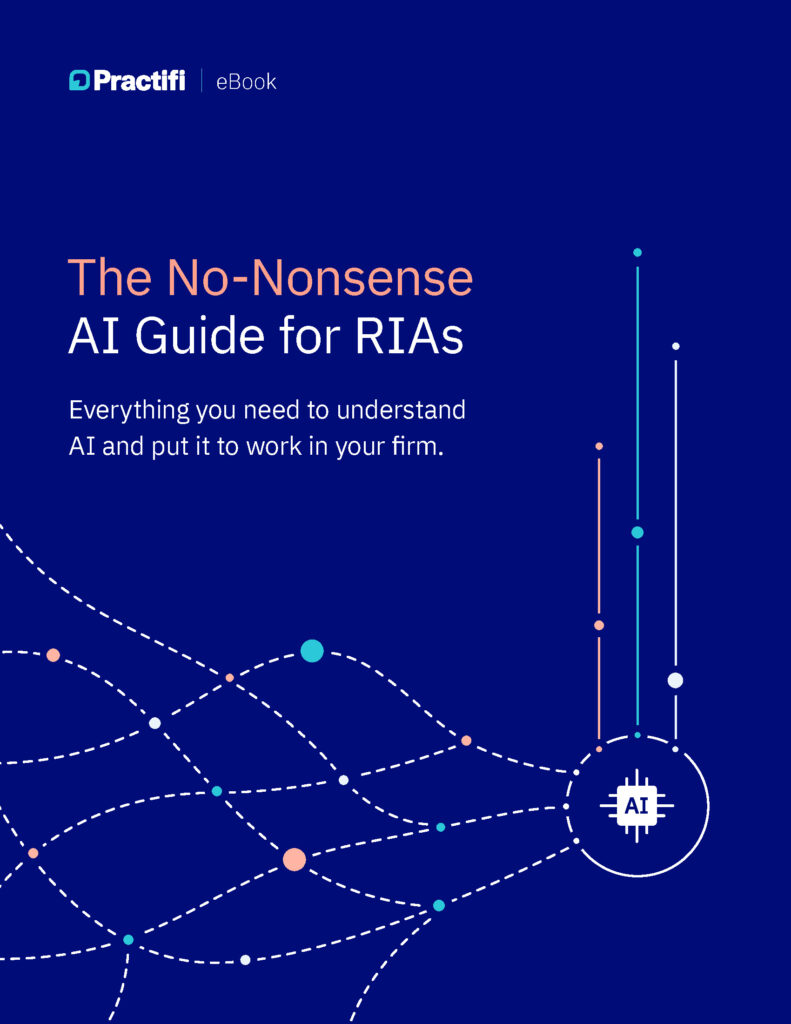
What Clients Think You’re Doing With Their Data
Trust is what makes advisory relationships work. It’s the reason clients choose to work with an independent firm, and the reason they stay when markets fluctuate or plans evolve. But as AI begins to play a more visible role in the platforms advisors use, that foundation of trust is starting to shift. Clients are forming quiet judgments. Not just about the advice they receive, but about how their personal information is being handled.
Client assumptions about how their data is being used can carry as much weight as your actual policies and practices. That doesn’t mean that perception replaces reality. But in practice, belief often drives behavior. If they assume their financial details are being pulled into systems they don’t fully understand — or worse, shared or sold — they may begin to question how much control they really have. That kind of doubt rarely shows up in direct conversation. It often shows up as hesitation, distance, or quiet disengagement.
Most clients won’t ask how AI works or where their data goes. But they notice changes. They see new tools, read headlines and start expecting answers. As technology partners to RIAs, we’ve seen how forward-thinking firms are approaching this moment. That work starts by recognizing the perception gap and treating transparency around data and AI as essential to building resilient, lasting client relationships.
The Client Mindset: Quiet Assumptions, Real Consequences
Most clients won’t ask detailed questions about how artificial intelligence fits into your tech stack, or where their data goes once it’s entered into a system. But that doesn’t mean they’re not thinking about it. What they are doing — consciously or not — is forming assumptions.
And those assumptions tend to fall into familiar patterns. For many clients, especially those outside the financial or tech industries, AI still feels opaque. Terms like “machine learning,” “large language models,” or “automation” raise more questions than they answer. In the absence of clear guidance, people fill in the gaps with worst-case scenarios or generalized fears drawn from headlines.
Below are some of the most common ones we’ve observed in conversations across the industry:
Assumption 1: “My personal financial data is being used to train AI.”
This is one of the most persistent concerns, and it’s not unfounded. In other industries, client data has been fed into machine learning systems without explicit consent, sometimes even without internal clarity on where the data goes.
When clients hear the word “AI,” they may not know the details, but they instinctively connect it to data collection, automation and loss of control. The assumption is often: If the platform is getting smarter, it must be learning from me.
Without direct guidance, even responsible firms who are not using AI in this way can find themselves subject to this unease.
Assumption 2: “AI is replacing my advisor’s judgement.”
Automation is often positioned as a value-add, but to a client, it may look like a shortcut. If a report, a recommendation or a message is generated by a system, clients may wonder how much of it was actually reviewed by their advisor, or whether the advisor is simply rubber-stamping machine output.
This doesn’t mean clients are anti-technology. But in a relationship built on personal trust, the presence of too much automation without context can feel impersonal, or even risky.
Assumption 3: “My data could end up somewhere it shouldn’t.”
This is the most general, and in some ways, the most emotionally charged concern. Many clients don’t differentiate between a system breach, a vendor policy or a software update. If they can’t see how their data is handled, stored and protected, they’re more likely to assume it’s vulnerable.
Security is only part of the equation. Visibility and accountability matters just as much. Clients want to know that someone is accountable, that there are boundaries in place, and that the firm they work with is making deliberate choices, not just following the latest tech trend.
Assumption 4: “You’re selling or sharing my data.”
This is one of the most deeply rooted fears clients have and one of the hardest to disprove without direct communication. In an era where many tech platforms monetize user data as part of their core business model, clients may assume that any digital system, including those used by their financial advisor, operates the same way.
Even if your firm has strict internal policies and zero tolerance for third-party sharing, those safeguards are often invisible to the client. Without a clear explanation, the assumption tends to default toward suspicion.
Advisors may never hear this concern voiced directly, but it can quietly affect how comfortable a client feels entering information, asking questions or embracing new technology introduced by the firm.
Each of these assumptions may never be spoken aloud but they still influence how clients engage with their advisor and the technology around them. When left unaddressed, quiet concerns often lead to hesitation. That can mean less transparency, less trust and ultimately a weaker connection. Recognizing these patterns is the first step toward closing the gap between what clients assume and what is actually true.
Turn Transparency Into a Competitve Edge
Most firms aren’t doing anything shady with client data. They’re not selling it, leaking it, or handing it over to AI tools without oversight. The real issue is simpler and a little quieter. Many firms aren’t saying enough about what’s actually happening behind the scenes.
And in a time when AI raises more questions than answers, that silence can create doubt. Clients don’t just want to know their data is safe. They want to know how it’s being used, where the boundaries are and whether someone’s still looking out for them. Strong policies are a good start, but the firms that stand out are the ones that explain them. They make it easy for clients to understand what’s in place and why it matters. And in most cases, they’re focused on a few key practices.
1. Define Clear Boundaries Around AI and Data
Firms using AI thoughtfully establish clear guidelines: which systems have access to client data, which ones don’t and where the line is drawn. In many cases, AI features can be designed to operate without ingesting personally identifiable information at all. That distinction matters, and it should be explained plainly to clients and advisors alike.
2. Make Human Judgment Central, Not Optional
Even the most advanced tools should reinforce, not replace, the advisor’s role. Advisors should be positioned as the final decision-maker, with AI serving in a supporting, efficiency-driving role. Leading firms are building their systems to reflect this priority.
3. Communicate Policies Before Clients Ask
Proactive communication goes further than a security page or compliance checkbox. It’s about giving advisors the language and confidence to explain how the firm approaches data and AI. Clients shouldn’t have to dig to understand whether their information is being used to train models or improve system performance. They should know, because someone told them.
4. Prioritize Transparency as a Strategic Differentiator
In a competitive advisory landscape, firms that explain their data practices simply and without jargon are earning trust in ways that go beyond investment performance. Clients don’t need a technical deep dive. They just want to know what’s happening and why it matters. Firms that treat transparency as a relationship strategy, not just a legal safeguard, are the ones clients trust most.
The Trust Contract: A New Standard for Transparency
When a client chooses to work with an RIA, there’s more at play than an account agreement or an investment strategy. There’s an unspoken, shared understanding. A sense that their advisor is on their side, looking out for their best interests and keeping their information safe.
That’s the trust contract.
It’s not written in legal terms, but it governs the relationship just as clearly. It’s built through honest conversations, consistent follow-through and the feeling that someone’s paying attention.
Now that AI is becoming part of the advisory process, this contract is being quietly rewritten. Clients may not say it out loud, but they’re being asked to put their faith in systems they can’t see. They’re trusting that their data isn’t being misused, that automation isn’t replacing care and that their advisor is still the one making the call. This moment calls for more than preserving trust, it calls for redefining it.
The introduction of AI into the advisor-client relationship brings new expectations. While most clients won’t understand the full scope of the technology, they can tell whether their advisor is prepared to have an open conversation or hesitant to address the topic at all. That difference is where leadership begins.
Resetting the trust contract means being intentional with how AI is used, explained and supported. It means:
- Framing technology as a tool that supports, not replaces, the advisor-client relationship
- Giving clients clear, concise explanations of how their data is used and what choices they have
- Reassuring them that human judgment remains central to every financial decision
For RIAs, this is a chance to lead. Not by avoiding AI, but by adopting it with transparency and purpose.
Trust Moves at the Speed of Communication
AI may be new territory for many firms, but trust is not. What’s changing is the context in which that trust is tested. Advisors are no longer judged only by the quality of their insights or the strength of their performance. They are also judged by how transparently they explain the tools they rely on and how they protect the data clients share.
The firms that thrive in this next chapter of wealth management will be the ones that treat trust not as a legacy advantage, but as an evolving responsibility. Now is the time to make that clear.












